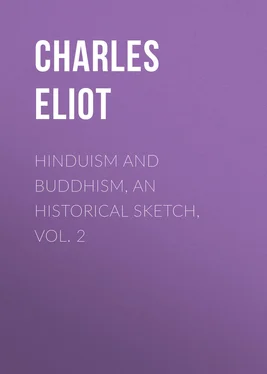Kshitigarbha is translated into Chinese as Ti-tsang and Jizō is the Japanese pronunciation of the same two characters.
In Ostasiat. Ztsft. 1913-15. See too Johnston, Buddhist China , chap. VIII.
The Earth goddess is known to the earliest Buddhist legends. The Buddha called her to witness when sitting under the Bo tree.
Three Sûtras, analysed by Visser, treat of Kshitigarbha. They are Nanjio, Nos. 64, 65, 67.
A celebrated monastery in the portion of An-hui which lies to the south of the Yang-tse. See Johnston, Buddhist China , chaps, VIII, IX and X.
There is some reason to think that even in Turkestan Kshitigarbha was a god of roads.
In Annam too Jizō is represented on horseback.
In Mahâparinib. Sut. I. 16 the Buddha is made to speak of all the other Buddhas who have been in the long ages of the past and will be in the long ages of the future.
Though Dhyâni Buddha is the title most frequently used in European works it would appear that Jina is more usual in Sanskrit works, and in fact Dhyâni Buddha is hardly known outside Nepalese literature. Ratnasambhava and Amoghasiddhi are rarely mentioned apart from the others. According to Getty ( Gods of Northern Buddhism , pp. 26, 27) a group of six, including the Âdi-Buddha himself under the name of Vajrasattva, is sometimes worshipped.
About the same period Śiva and Vishnu were worshipped in five forms. See below, Book V. chap. III. sec. 3 ad fin.
Nanjio, Cat. No. 28.
Virocana also occurs in the Chândogya Up. VIII. 7 and 8 as the name of an Asura who misunderstood the teaching of Prajâpati. Verocana is the name of an Asura in Sam. Nik. I. xi. 1. 8.
The names of many of these Buddhas, perhaps the majority, contain some word expressive of light such as Âditya, prabhâ or tejas.
Chap. XX. Pushpavalivanârajikusumitâbhijña.
E.g. Yashts. XXII. and XXIV. S.B.E. vol. XXIII. pp. 317 and 344. The title Pure Land (Chinese Ch'ing-t'u, Japanese Jo-do) has also a Persian ring about it. See further in the chapter on Central Asia.
Vishnu P., Book III. chap. II.
See below: Section on Central Asia, and Grünwedel, Mythologie , 31, 36 and notes: Taranatha (Shiefner), p. 93 and notes.
Amitâyur-dhyâna-sûtra. All three works are translated in S.B.E. vol. XLIX.
Praṇidhâna. Not only Amitâbha but all Bodhisattvas (especially Avalokita and Kshitigarbha) are supposed to have made such vows. This idea is very common in China and Japan but goes back to Indian sources. See e.g. Lotus, XXIV. verse 3.
These Bodhisattvas are also mentioned but without much emphasis in the Greater Sukhâvatî-vyûha.
Even in Hinayanist works such as the Nidânakathâ Sumedha's resolution to become a Buddha, formed as he lies on the ground before Dipankara, has a resemblance to Amîda's vow. He resolves to attain the truth, to enable mankind to cross the sea of the world and only then to attain Nirvana.
See Foucher, Iconographie Bouddhique dans l'Inde.
The Bhagavad-gîtâ states quite clearly the doctrine of the deathbed prayer (VIII. ad init.). "He who leaves this body and departs remembering me in his last moments comes to my essence. Whatever form (of deity) he remembers when he finally leaves this body, to that he goes having been used to ponder on it."
See art. Âdi-Buddha in E.R.E. Asanga in the Sûtrâlankâra (IX. 77) condemns the doctrine of Âdi-Buddha, showing that the term was known then, even if it had not the precise dogmatic sense which it acquired later. His argument is that no one can become a Buddha without an equipment (Sambhâra) of merit and knowledge. Such an equipment can only be obtained from a previous Buddha and therefore the series of Buddhas must extend infinitely backwards.
For the prevalence of the doctrine in mediæval Bengal see B.K. Sarkar, Folklore Element in Hindu Culture , which is however sparing of precise references. The Dharma or Nirañjana of the Śûnya Purâna seems to be equivalent to Âdi-Buddha.
Sometimes the Âdi-Buddha is identified with Vajrasattva or Samantabhadra, although these beings are otherwise classified as Bodhisattvas. This appears analogous to the procedure common in Hinduism by which a devotee declares that his special deity is all the gods and the supreme spirit.
It would appear that some of the Tantras treat of five bodies, adding to the three here given others such as the Ânandakâya, Vajrakâya and Svabhâvakâya. For this doctrine see especially De la Vallée Poussin, J.R.A.S. 1906, pp. 943-997 and Muséon , 1913, pp. 257 ff. Jigs-med nam-mká, the historian of Tibetan Buddhism, describes four. See Huth, Ges. d. Bud. in d. Mongolei , vol. II. pp. 83-89. Hinduism also assigns to living beings three bodies, the Kâraṇa-śarîra, lingaś. and sthûlaś.
Translated into Chinese by Dharmaraksha between 397 and 439 A.D.
The prototype of the Sambhoga-kâya is found in the Pali Canon, for the Buddha says (Mahâparinib. Sut. III. 22) that when he appears among the different classes of gods his form and voice are similar to theirs.
Watters, vol. II. p. 38. "Spiritual essence" is Fa-shên in Chinese, i.e. Dharma-kâya. Another pass age is quoted to the effect that "henceforth the observances of all my disciples constitute the Tathâgata's Fa-shên, eternal and imperishable."
Mahâparinib. Sut. VI. i.
Something similar might happen in English if think and thing were pronounced in the same way and a thing were believed to be that which we can think.
See Ashtasâhasrikâ Prajñâ-pâramitâ, chap. IV, near beginning.
It is in this last point that no inferior intelligence can follow the thought of a Buddha.
The Awakening of Faith , Teitaro Suzuki, p. 59.
E.g. in Mahâparinib. Sut. IV. 57, the Buddha says "There has been laid up by Cunda the smith (who had given him his last meal) a karma, redounding to length of life, to good fortune, to good fame, to the inheritance of heaven , and of sovereign power."
Strictly speaking Madhyamaka is the name of the school Mâdhyamika of its adherents. Both forms are used, e.g. Madhyamakakârikâs and Mâdhyamikasûtra.
Nâgârjuna says Śûnyam iti na vaktavyam aśûnyam iti va bhavet Ubhayam nobhayam ceti prâjñâptyartham tu kathyate, "It cannot be called void or not void or both or neither but in order to somehow indicate it, it is called Śûnyatâ."
Sam. Nik. XXII. 90. 16.
Читать дальше












